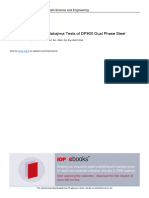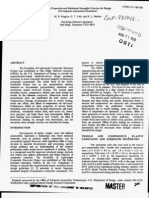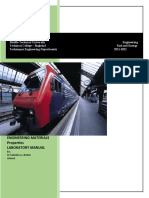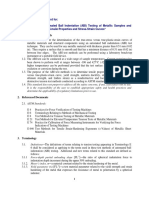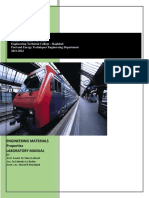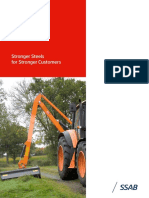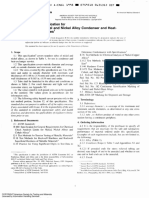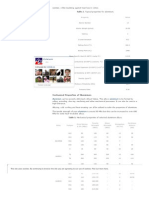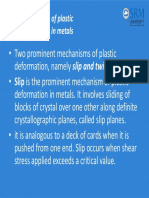07-A Aerospace 048
07-A Aerospace 048
Uploaded by
FABIAN FIENGOCopyright:
Available Formats
07-A Aerospace 048
07-A Aerospace 048
Uploaded by
FABIAN FIENGOCopyright
Available Formats
Share this document
Did you find this document useful?
Is this content inappropriate?
Copyright:
Available Formats
07-A Aerospace 048
07-A Aerospace 048
Uploaded by
FABIAN FIENGOCopyright:
Available Formats
14th International LS-DYNA Users Conference Session: Aerospace
Material Testing for Development and Calibration of
Material models for Plastic Deformation and Failure
Amos Gilat and Jeremy Seidt
The Ohio State University Department of Mechanical and Aerospace Engineering
Columbus OH, USA
Abstract
Material testing at various, loading conditions, temperatures, and strain rates is used for
studying plastic deformation and failure of materials. The data from such tests is used for
developing and calibrating material model that are utilized in numerical codes that are used for
simulations of practical applications. The presentation will review experimental techniques used
in such testing with emphasis on the integration of Digital Image Correlation (DIC) for
measuring full-field deformations and the development of new tests. Of special interest is the
testing needed for supporting the new deformation and failure model MAT224 in LS-DYNA.
This material model is based on experimental determination of a failure surface that gives the
equivalent plastic strain to failure as a function of stress triaxiality and the Lode parameter. It is
done by testing specimens that are subjected to uniform and nonuniform states of stress and
deformation and determining the failure state (deformation and stress) from matching the
simulation of the test with the DIC and load measurements. Testing can be done at room
temperature or, by using a special furnace, at elevated temperatures (up to 850C). In addition,
a new experimental setup in which full-field deformation and full-field temperature are measured
simultaneously on the surface of a specimen during a tensile test is introduced. Results from
testing specimens made of stainless steel show a significant temperature increase in the neck
area in a quasi-static tension test. In most material models (e.g. Johnson Cook) the effect of
strain hardening and temperature softening are uncoupled. The data that is typically used for
determining the parameters in the models is obtained from experiments where strain hardening
and temperature are coupled. The results from the new experimental setup can be used for
uncoupling the effect of strain hardening and thermal softening during plastic deformation.
Background
Numerical simulation of the response of materials under loads has reached a level of maturity at
which it can be used with confidence for design purposes. Numerical codes like LS-DYNA
include many material models for deformation and failure (constitutive relations) that can be
selected for specific applications. The various models require input parameters that are specific
to the material that is being simulated. The accuracy of the simulations depends on the values of
the input parameters which are determined from experimental data.
The focus of the present paper is on the testing configurations and techniques that have
been developed recently for the purpose of providing accurate data for determining the
parameters in material models for deformation and failure. Of special interest is MAT224 which
is a relatively new deformation and failure model in LS-DYNA. The input requires stress strain
June 12-14, 2016 1-1
Session: Aerospace 14th International LS-DYNA Users Conference
curves from tests at different strain rates and temperatures and values of equivalent failure strain
at various state of stress (various combinations of stress triaxiality and Lode parameter).
Uniaxial Stress Tests at Various Strain Rates and Temperatures
Uniaxial (tension, compression, shear) tests can be done at various strain rates and temperatures.
At quasi-static strain rates between 10-4 s-1 and 1 s-1 they are done using a hydraulic machine. At
strain rates above 500 s-1 they are done using the split Hopkinson bar (SHB) technique. A special
machine was developed for testing in tension and compression at intermediate strain rates of 10
s-1 to 200 s-1. The technique is a hybrid of a SHB and a hydraulic machine. A specimen that is
placed between the end of a long bar and a hydraulic actuator is loaded by the hydraulic actuator,
Fig. 1. As the specimen is loaded, a wave propagates to the end of the bar and reflects back. The
force in the specimen is measured by strain gages that are placed on the bar and the strain in
measured directly on the specimen with DIC. The actual setup is shown in Figs. 2 and 3.
Fig. 1: Schematic of the intermediate strain rate apparatus.
Fig. 2: Intermediate strain rate apparatus. Fig. 3: Intermediate strain rate apparatus.
The bar is more than 40 m long which allows a test duration (until the reflected wave arrives at
the strain gages that measure the force) of more than 0.016 s. At a strain rate of 20 s-1 it provides
enough time for the specimen to deform to a strain of 0.3. Results from tensile testing of HHS at
various strain rates are shown in Figs. 4.
Fig. 4: Tensile stress strain curves for HHS at different strain rates.
1-2 June 12-14, 2016
14th International LS-DYNA Users Conference Session: Aerospace
Data for Determining the Failure Surface
The data for determining the failure surface is obtained from tension tests of notched flat and
notched round specimens with different notch dimensions, plane strain tension experiments with
smooth and notched specimens with different notch sizes, and biaxial tension-torsion and
compression-torsion tests and punch tests. Digital Image Correlation (DIC) is used in all the tests
for a direct measurement of the deformation (full field) on the surface of the specimens. The DIC
data together with numerical simulation of the experiments is used for determining the state of
stress (triaxiality and Lode parameter) and deformation in the specimens throughout the test and
at the instant of fracture. For example, a comparison between DIC experimental data and
numerical simulation is shown in Fig. 5. DIC data from tensile testing of flat-notched-specimens
with different notch sizes is shown in Fig. 6.
Fig. 5: DIC data and numerical simulation of a tensile test.
Fig. 6: DIC data from tensile testing of flat-notched-specimens.
Full-Field Deformation and Temperature Measurements
A new experimental setup, in which full-field deformation and full-field temperature are
measured simultaneously on the surface of a specimen during tensile tests at various strain rates
has been recently developed. The setup consists of a flat thin specimen and visual cameras on
one side of the specimen and a high speed IR camera on the other side. The set up for a high
strain rate test with the tensile SHB technique is shown is Fig. 7. Synchronized DIC and IR
images recorded in a test are shown in Fig. 8. Results from testing a specimen made of stainless
steel at a strain rate of about 3000 s-1 show that the strain in the necking region of the specimen
exceeds 0.6 and the temperature exceeds 300C. The results from these tests provide data that
June 12-14, 2016 1-3
Session: Aerospace 14th International LS-DYNA Users Conference
can be used for uncoupling the effects of strain hardening and temperature softening in plasticity
models.
Fig. 7: Tensile Split Hopkinson bar with full-field deformation and temperature measurements.
Fig. 8: DIC processed images recorded by the visual camera and IR camera images at different
times during the test.
Acknowledgements
The development of the testing techniques for the data needed for MAT224 was supported by the
U.S.A. Federal Aviation Administration, Grants No. 06-G-004 and 11-G-003. The authors are
grateful to Mr. Bill Emmerling, Dr. Chip Queitzsch, and Mr. Don Altobelli of the FAA. The
development of the intermediate strain rate test was done by Mr. Thomas Matrka with support
from NASA, Grant No. NNX08AB50A.
1-4 June 12-14, 2016
You might also like
- AISC Steel Construction Manual 14th Edition + ANSI-AISC 360-10 Specifications For Structural Steel BuildingDocument2,325 pagesAISC Steel Construction Manual 14th Edition + ANSI-AISC 360-10 Specifications For Structural Steel BuildingKhurram Shahzad Amjad95% (107)
- Flexural or Bending Test Lab ReportDocument9 pagesFlexural or Bending Test Lab ReportKalKatu MaLam73% (22)
- Thick Cylinder Laboratory ExerciseDocument7 pagesThick Cylinder Laboratory Exercisemohammed33% (6)
- Strength of Materials ReportDocument14 pagesStrength of Materials ReportRahul JohnsonNo ratings yet
- Aluminum Silicon Casting AlloysDocument126 pagesAluminum Silicon Casting AlloysEdson Araga67% (3)
- Multiaxial Fatigue Under Variable Amplitude Loads: K. S. Kim J. C. Park J. W. LeeDocument8 pagesMultiaxial Fatigue Under Variable Amplitude Loads: K. S. Kim J. C. Park J. W. LeeJithendra KumarNo ratings yet
- Tensile TestDocument9 pagesTensile Testonkod1No ratings yet
- Damage Evolution in Nakajima Tests of DP800 Dual PDocument7 pagesDamage Evolution in Nakajima Tests of DP800 Dual PĐạt TriệuNo ratings yet
- Durability Design US 1998Document9 pagesDurability Design US 1998lecotier33No ratings yet
- Author's Accepted Manuscript: Data in BriefDocument14 pagesAuthor's Accepted Manuscript: Data in BriefAdnen LaamouriNo ratings yet
- Creeps Analysis of ThermoplasticsDocument7 pagesCreeps Analysis of ThermoplasticsIgor AlarcónNo ratings yet
- Tensile Testing Basics Tips TrendsDocument5 pagesTensile Testing Basics Tips TrendsJonathan Elias MoralesNo ratings yet
- Tension LabDocument4 pagesTension LabWilliamMermell100% (1)
- Lab Manual: International Islamic University Malaysia Department of Mechanical EngineeringDocument36 pagesLab Manual: International Islamic University Malaysia Department of Mechanical EngineeringMuhamad HilmiNo ratings yet
- Mechanical Properties of Biomaterials Compressive Test: Experiment #2 Pre LabDocument3 pagesMechanical Properties of Biomaterials Compressive Test: Experiment #2 Pre LabABEER FAWZINo ratings yet
- Impact - Test and Fracture TestDocument14 pagesImpact - Test and Fracture TestMinh Tam CaoNo ratings yet
- Split Hopkinson Pressure Bar Apparatus For Compression Testing: A ReviewDocument6 pagesSplit Hopkinson Pressure Bar Apparatus For Compression Testing: A ReviewUdhamNo ratings yet
- Tpu 15Document4 pagesTpu 15namasse.medamineNo ratings yet
- Ac 2008-1447: Undergraduate Materials Research: Tensile Impact Toughness of PolymersDocument10 pagesAc 2008-1447: Undergraduate Materials Research: Tensile Impact Toughness of PolymersDeva RajNo ratings yet
- Fatigue-Striation Counting MethodDocument8 pagesFatigue-Striation Counting MethodObeydullahKhanNo ratings yet
- Design and construct a Horizontal tensile testing machine for polymer compositesDocument49 pagesDesign and construct a Horizontal tensile testing machine for polymer compositeschinweubaonovoNo ratings yet
- Friction in Ls Dyna R Experimental Characterization and Modeling ApplicationDocument11 pagesFriction in Ls Dyna R Experimental Characterization and Modeling ApplicationArun Kumar YadavNo ratings yet
- 2Document10 pages2NamanMishraNo ratings yet
- Impact Testing of Stainless Steel Materials: ICP/CON-04-00633 PreprintDocument10 pagesImpact Testing of Stainless Steel Materials: ICP/CON-04-00633 Preprintbabis1980No ratings yet
- Laboratory Rock Mechanics: MNG 551-001 Laboratory #6 Elastic Moduli and Constants ASTM D4543 &7012Document7 pagesLaboratory Rock Mechanics: MNG 551-001 Laboratory #6 Elastic Moduli and Constants ASTM D4543 &7012PhilipeInneccoNo ratings yet
- New Method of Detection of HydrogenDocument11 pagesNew Method of Detection of HydrogenYingzhi LiNo ratings yet
- Material Testing Lab: Structures/Motion Lab 20-263-571, Sections 001, 002, 003Document16 pagesMaterial Testing Lab: Structures/Motion Lab 20-263-571, Sections 001, 002, 003med2011GNo ratings yet
- Tensile Test PresentationDocument36 pagesTensile Test PresentationalkharfaneNo ratings yet
- Uniaxial Tension TestingDocument6 pagesUniaxial Tension Testinganil chejara100% (1)
- Tensile TestDocument6 pagesTensile TestMohamed EmadNo ratings yet
- Tensile Test (Zuhair)Document4 pagesTensile Test (Zuhair)SaifAdamz'sNo ratings yet
- Evaluation of The Materials Damage in Gas TurbineDocument9 pagesEvaluation of The Materials Damage in Gas TurbineThanapaet RittirutNo ratings yet
- Tensile Testing by Odewole TemidayoDocument10 pagesTensile Testing by Odewole Temidayostephenoladipo21No ratings yet
- Tensile and Compressive Behaviour of S355 Midl Steel in A Wide Tange of Strain Rates PDFDocument15 pagesTensile and Compressive Behaviour of S355 Midl Steel in A Wide Tange of Strain Rates PDFdgiddingsNo ratings yet
- Water Impact: Experimental Tests and Numerical Simulations Using Meshless MethodsDocument12 pagesWater Impact: Experimental Tests and Numerical Simulations Using Meshless Methodsbb06412000No ratings yet
- Bangladesh University of Engineering and Technology: Submitted byDocument8 pagesBangladesh University of Engineering and Technology: Submitted byRefat Bin SultanNo ratings yet
- Sokoine University of Agriculture: Department of Engineering Sciences and TechnologyDocument16 pagesSokoine University of Agriculture: Department of Engineering Sciences and TechnologyEngr.Hamid Ismail CheemaNo ratings yet
- Engineering Materials Properties Laboratory Manual: BY: DR - Sabeeha A.J.Beden AhmedDocument66 pagesEngineering Materials Properties Laboratory Manual: BY: DR - Sabeeha A.J.Beden Ahmedb964 SpeedNo ratings yet
- Measurement: W. Zurowski, J. Zepchło, D. Kana Ska, M. RuckiDocument7 pagesMeasurement: W. Zurowski, J. Zepchło, D. Kana Ska, M. RuckiSonja KostićNo ratings yet
- Uniaxial Tension Compression Tests and Cyclic BendingDocument10 pagesUniaxial Tension Compression Tests and Cyclic Bendingmodestboy110No ratings yet
- Flexible Adhesives Workshop Handout 12june01Document4 pagesFlexible Adhesives Workshop Handout 12june01vilukNo ratings yet
- Characterisation of Damage in Hyperelastic Materials Using AbaqusDocument15 pagesCharacterisation of Damage in Hyperelastic Materials Using AbaqusVenu KishoreNo ratings yet
- High Temperature Mechanical TestingDocument6 pagesHigh Temperature Mechanical TestingSoupramanien KathirvelouNo ratings yet
- Prediction of The Plastic Component Parts Durability With Use of A Drop Test SimulationDocument7 pagesPrediction of The Plastic Component Parts Durability With Use of A Drop Test Simulationxaaabbb_550464353No ratings yet
- "Test Methods For Automated Ball Indentation (ABI) Testing of Metallic Samples and PDFDocument24 pages"Test Methods For Automated Ball Indentation (ABI) Testing of Metallic Samples and PDFSmlfAlawameNo ratings yet
- تقارير معمليةDocument56 pagesتقارير معمليةFaraj HaiderNo ratings yet
- Load Transfer of Polycarbonate Blast Resistant Glazing SystemsDocument10 pagesLoad Transfer of Polycarbonate Blast Resistant Glazing SystemsDiego Zenteno CornejoNo ratings yet
- ملزمة العملي للخواصDocument69 pagesملزمة العملي للخواصyousifNo ratings yet
- High Temperature Fretting Tribometer - Study of The Dynamic Behaviour and Tangential Load MeasurementDocument11 pagesHigh Temperature Fretting Tribometer - Study of The Dynamic Behaviour and Tangential Load MeasurementAsaNo ratings yet
- 2021 - Experimental Determination of The Effect of Change in Relative RoughnessDocument4 pages2021 - Experimental Determination of The Effect of Change in Relative RoughnessSharmila BadgujarNo ratings yet
- Experiment 4 - Testing of Materials in Tension: Engineering Stress (Lbs/inDocument4 pagesExperiment 4 - Testing of Materials in Tension: Engineering Stress (Lbs/inneel12321No ratings yet
- J-R Curve For Storage TankDocument21 pagesJ-R Curve For Storage TankdonghuyphuongNo ratings yet
- Solid Mechanics 20ME006Document72 pagesSolid Mechanics 20ME006Prathmesh AwaghadeNo ratings yet
- Experimental and Numerical Analysis of An In-Plane Shear Specimen Designed For Ductile Fracture StudiesDocument11 pagesExperimental and Numerical Analysis of An In-Plane Shear Specimen Designed For Ductile Fracture StudieskamdevxNo ratings yet
- Experiment 1-Tensile TestDocument7 pagesExperiment 1-Tensile Testhazriel83% (6)
- Tensile and Compression TestingDocument2 pagesTensile and Compression TestingReymond AbayonNo ratings yet
- Ceramic Materials for Energy Applications V: A Collection of Papers Presented at the 39th International Conference on Advanced Ceramics and CompositesFrom EverandCeramic Materials for Energy Applications V: A Collection of Papers Presented at the 39th International Conference on Advanced Ceramics and CompositesJosef MatyášNo ratings yet
- Instruments, Measurement Principles and Communication Technologies for Downhole Drilling EnvironmentsFrom EverandInstruments, Measurement Principles and Communication Technologies for Downhole Drilling EnvironmentsNo ratings yet
- Mechanical Properties and Performance of Engineering Ceramics and Composites XIFrom EverandMechanical Properties and Performance of Engineering Ceramics and Composites XIJonathan SalemNo ratings yet
- Materiales FragilesDocument1 pageMateriales FragilesFABIAN FIENGONo ratings yet
- Second Moment of AreaDocument6 pagesSecond Moment of AreaFABIAN FIENGONo ratings yet
- Numerical Modeling of ElastomersDocument13 pagesNumerical Modeling of ElastomersFABIAN FIENGONo ratings yet
- Open SourceDocument11 pagesOpen SourceFABIAN FIENGONo ratings yet
- Comportamiento ViscoelasticoDocument20 pagesComportamiento ViscoelasticoFABIAN FIENGONo ratings yet
- Modelacion de Materiales CompuestosDocument1 pageModelacion de Materiales CompuestosFABIAN FIENGONo ratings yet
- Mikhail Lomonosov PDFDocument76 pagesMikhail Lomonosov PDFFABIAN FIENGONo ratings yet
- User Defined Material Modeling in Ls-DynaDocument1 pageUser Defined Material Modeling in Ls-DynaFABIAN FIENGONo ratings yet
- Shear Wall-Frame Interaction PDFDocument9 pagesShear Wall-Frame Interaction PDFFABIAN FIENGO100% (1)
- Paper MossakovskyDocument12 pagesPaper MossakovskyFABIAN FIENGONo ratings yet
- Concrete Pavement Slab Under Blast Loads: Bibiana Marı A Luccioni, Mariela LuegeDocument19 pagesConcrete Pavement Slab Under Blast Loads: Bibiana Marı A Luccioni, Mariela LuegeFABIAN FIENGONo ratings yet
- Schleyer 2012Document13 pagesSchleyer 2012FABIAN FIENGONo ratings yet
- Finite Element Analysis of RC Rectangular Shear Walls Under Bi-Directional LoadingDocument13 pagesFinite Element Analysis of RC Rectangular Shear Walls Under Bi-Directional LoadingFABIAN FIENGONo ratings yet
- Children's Clothes Are Very Expensive.: Its, Your, My, Their, Our, Her, HisDocument3 pagesChildren's Clothes Are Very Expensive.: Its, Your, My, Their, Our, Her, HisFABIAN FIENGONo ratings yet
- Numerical Analysis of High Strain Rate Concrete Direct Tension TestsDocument15 pagesNumerical Analysis of High Strain Rate Concrete Direct Tension TestsFABIAN FIENGONo ratings yet
- Comparison: Adverbs (Worse, More Easily) : Adverbs: Comparative and Superlative FormsDocument9 pagesComparison: Adverbs (Worse, More Easily) : Adverbs: Comparative and Superlative FormsFABIAN FIENGONo ratings yet
- Apposition: English Grammar TodayDocument1 pageApposition: English Grammar TodayFABIAN FIENGONo ratings yet
- Adjective PlacementDocument15 pagesAdjective PlacementFABIAN FIENGONo ratings yet
- Check Your English Vocabulary For TOEFLDocument13 pagesCheck Your English Vocabulary For TOEFLFABIAN FIENGO100% (1)
- Jordan University of Science and Technology Faculty of Engineering Industrial Engineering Department Engineering Materials Lab (IE367)Document10 pagesJordan University of Science and Technology Faculty of Engineering Industrial Engineering Department Engineering Materials Lab (IE367)fatema eyadNo ratings yet
- AISC Seismic Design-Module4-Eccentrically Braced FramesDocument134 pagesAISC Seismic Design-Module4-Eccentrically Braced FramesMiguel A Zuñiga100% (2)
- Metal Forming - FundamentalDocument35 pagesMetal Forming - FundamentalR ChannelNo ratings yet
- 301 - Domex - Stronger Steel For Stronger CustomerDocument20 pages301 - Domex - Stronger Steel For Stronger CustomerNOIVODALAGOA100% (1)
- Astm B163Document11 pagesAstm B163mmlingNo ratings yet
- MSMBM Oct 2022 - 2Document2 pagesMSMBM Oct 2022 - 2battuarunNo ratings yet
- On The Relationship Between Microstructure, Strength and Toughness in AA7050 Aluminum AlloyDocument11 pagesOn The Relationship Between Microstructure, Strength and Toughness in AA7050 Aluminum Alloypavan_1988No ratings yet
- Steel Grades en 10028 ASTMDocument24 pagesSteel Grades en 10028 ASTMGeorge_Wabag_2014No ratings yet
- Titanium Guide PDFDocument48 pagesTitanium Guide PDFthanghanvicoNo ratings yet
- Mumetal Permimphy Supermimphy EngDocument10 pagesMumetal Permimphy Supermimphy Englemco7777No ratings yet
- Temper Designations of Magnesium Alloys, Cast and Wrought: Standard Practice ForDocument3 pagesTemper Designations of Magnesium Alloys, Cast and Wrought: Standard Practice FormahfuzNo ratings yet
- Aluminium - Specifications, Properties, Classifications and Classes, Supplier Data by AalcoDocument2 pagesAluminium - Specifications, Properties, Classifications and Classes, Supplier Data by Aalcowongtathong1987No ratings yet
- Ansys WorkBench Engineering DataDocument34 pagesAnsys WorkBench Engineering DatacivicbladeNo ratings yet
- Yield Strength MatcalcDocument91 pagesYield Strength MatcalcSibnath Kayal0% (1)
- NotesDocument19 pagesNotesvenkatdasNo ratings yet
- MT-1 Full NotesDocument56 pagesMT-1 Full NotesM.Saravana Kumar..M.ENo ratings yet
- MCQ MPDocument27 pagesMCQ MPEr Vishal Divya Jagadale67% (3)
- Materials ScienceDocument0 pagesMaterials ScienceN Dhanunjaya Rao BorraNo ratings yet
- AISI 1022 Low Carbon SteelDocument3 pagesAISI 1022 Low Carbon SteelArfahHamzahNo ratings yet
- KIT Zugversuche Study V19 190115Document32 pagesKIT Zugversuche Study V19 190115Abdullah tahaNo ratings yet
- Mechanisms of Plastic Deformation in MetalsDocument12 pagesMechanisms of Plastic Deformation in Metalsjimaerospace05No ratings yet
- MXA MCD Chapter 1-2Document57 pagesMXA MCD Chapter 1-2yaldarimNo ratings yet
- TMPT-2022-0135 R1 ReviewerDocument17 pagesTMPT-2022-0135 R1 ReviewerjasvindersinghsagguNo ratings yet
- Crack Cause Analysis of Pulverizing Wheel in Fan Mill of 600 MWDocument14 pagesCrack Cause Analysis of Pulverizing Wheel in Fan Mill of 600 MWPhoenix RomeoNo ratings yet
- Mechanical PropertiesDocument57 pagesMechanical PropertiesElmedin Gluhic100% (1)
- Plastic Deformation of Metals:: Variables in Metal Forming and Their OptimizationDocument14 pagesPlastic Deformation of Metals:: Variables in Metal Forming and Their OptimizationAshok PradhanNo ratings yet
- Electrolytically Galvanized Sheet: EMW Delivery Range Coils Slit Strip Cut-To-Size SheetDocument4 pagesElectrolytically Galvanized Sheet: EMW Delivery Range Coils Slit Strip Cut-To-Size SheetEvka AkováNo ratings yet
- Lab Manual PDFDocument58 pagesLab Manual PDFSamiha Maysoon NooriaNo ratings yet
- Fundamentals of Friction - Macroscopic and Microscopic ProcessesDocument637 pagesFundamentals of Friction - Macroscopic and Microscopic ProcessesAditi Sen100% (1)







